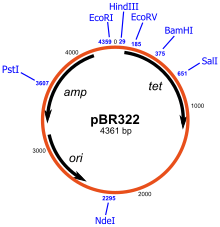Yeast artificial chromosome
Yeast artificial chromosomes (YACs) are genetically engineered chromosomes derived from the DNA of the yeast,
The bakers' yeast S. cerevisiae is one of the most important experimental organisms for studying eukaryotic molecular genetics.[1]
Beginning with the initial research of the Rankin et al., Strul et al., and Hsaio et al., the inherently fragile chromosome was stabilized by discovering the necessary autonomously replicating sequence (ARS);[2] a refined YAC utilizing this data was described in 1983 by Murray et al.[3]
The primary components of a YAC are the ARS,

Construction
A YAC is built using an initial circular DNA plasmid, which is typically cut into a linear DNA molecule using restriction enzymes; DNA ligase is then used to ligate a DNA sequence or gene of interest into the linearized DNA, forming a single large, circular piece of DNA.[3] [5] The basic generation of linear yeast artificial chromosomes can be broken down into 6 main steps:
- Ligation of selectable marker into plasmid vector: this allows for the differential selection of colonies with, or without the marker gene. An transformed with YAC only, will form colorless colonies. Cloning of a foreign DNA fragment into the YAC causes insertional inactivation of the gene, restoring the red color. Therefore, the colonies that contain the foreign DNA fragment are red.[5]
- Ligation of necessary centromeric sequences for mitotic stability[6]
- Ligation of Autonomously Replicating Sequences (ARS) providing an origin of replication to undergo mitotic replication. This allows the plasmid to replicate extrachromosomally, but renders the plasmid highly mitotically unstable, and easily lost without the centromeric sequences.[4][7]
- Ligation of artificial telomeric sequences to convert circular plasmid into a linear piece of DNA [8]
- Insertion of DNA sequence to be amplified (up to 1000kb)
- Transformation yeast colony[9]
Full chromosome III
Chromosome III is the third smallest chromosome in S. cerevisiae; its size was estimated from pulsed-field gel electro- phoresis studies to be 300–360 kb[10]
This chromosome has been the subject of intensive study, not least because it contains the three genetic loci involved in mating-type control: MAT, HML and HMR.[11] In March 2014,
The procedure involved replacing the genes in the original chromosome with synthetic versions and the finished synthesized chromosome was then integrated into a yeast cell. It required designing and creating 273,871 base pairs of DNA - fewer than the 316,667 pairs in the original chromosome.Uses in biotechnology
Yeast expression vectors, such as YACs,
This is significant in that it allows for the detailed mapping of specific regions of the genome. Whole human chromosomes have been examined, such as the X chromosome,[16] generating the location of genetic markers for numerous genetic disorders and traits.[17]

The Human Genome Project
In the United States, the Human Genome Project first took clear form in February of 1988, with the release of the National Research Council (NRC) report Mapping and Sequencing the Human Genome.
- BACs are much quicker to generate, and when generating redundant libraries of clones, this is essential
- BACs allow more dense coverage with STSs, resulting in more complete and efficient minimum tiling paths generated in silico.
However, it is possible to utilize both approaches, as was demonstrated when the genome of the nematode, C. elegans. There majority of the genome was tiled with BACs, and the gaps filled in with YACs.[21]
See also
- Bacterial artificial chromosome (BAC)
- Cosmid
- Fosmid
- Genetic engineering
- Human artificial chromosome
- Autonomously replicating sequence(ARS)
- Cloning Vector
References
- ISBN 0-87969-149-2.
- PMID 386351.
- ^ S2CID 4337825.
- ^ PMID 322128.
- ^ Strachan T. (2011). Human molecular genetics / Tom Strachan and Andrew Read, 4th ed.
- S2CID 4348814.
- PMID 375221.
- PMID 6765606.
- PMID 3033825.
- S2CID 4271784.
- S2CID 4271784.)
{{cite journal}}: CS1 maint: multiple names: authors list (link - ^ Shukman, David (27 March 2014). "Scientists hail synthetic chromosome advance". BBC News. Retrieved 2014-03-28.
- PMID 24674868.
- ^ Burke, D., Carle, G. & Olson, M. Cloning of large segments of exogenous DNA into yeast by means of artificial chromosome vectors. Science 236, 806–812 (1987).
- PMID 1427839.
- PMID 15772651.
- S2CID 12997875.
- PMID 8506271.
- PMID 7713499.
- PMID 2000377.
- ^ a b Rowen, L., Mahairas, G. & Hood, L. Sequencing the Human Genome. Science (1997).
- PMID 11237014.
External links
- Yeast+Artificial+Chromosomes at the U.S. National Library of Medicine Medical Subject Headings (MeSH)
- North Dakota State University Cloning and Cloning Vectors Resource
- Molecular Cell Biology 4th Edition [NCBI Database]: DNA Cloning with Plasmid Vectors, Ch. 7
- Washington University Genome Institute
- Saccharomyces Genome Database
